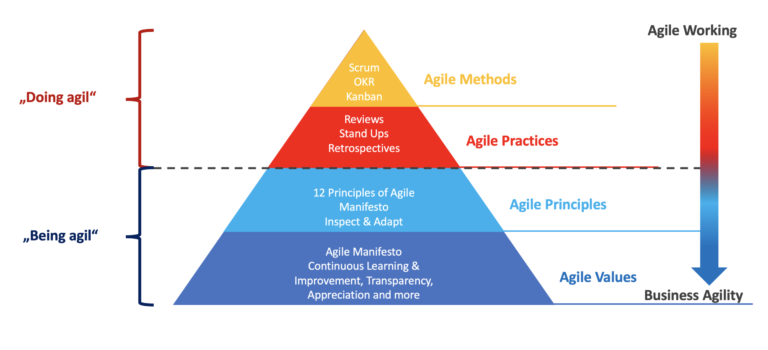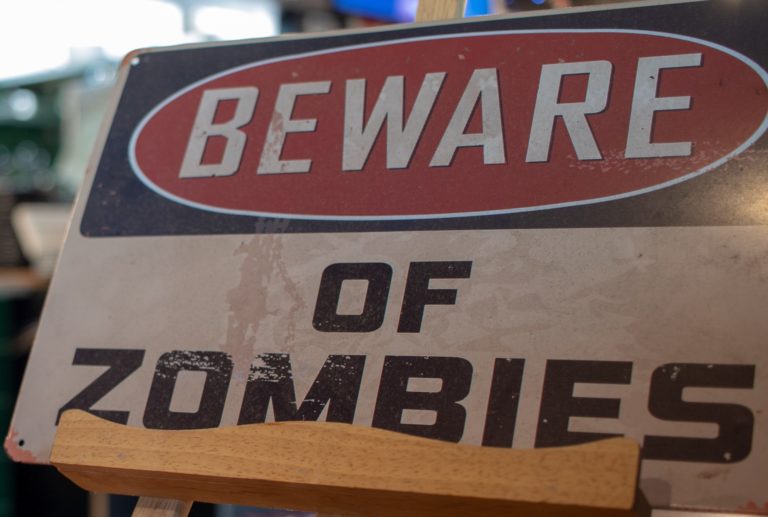Agile and DevOps are more than just methods!
Whenever companies, teams or individuals pretend to do agile, it is worth taking a closer look what it really means. There are at least four main levels of agile. The first is using Agile Methods like Scrum or Kanban or others just to manage the work or maybe because of the “everyone is doing it” reason.
The second level is that teams start agile practices like doing retrospectives frequently or having standups or reviews.
On the third level teams try to apply the 12 Principles of the agile Manifesto to their daily work. The idea of Inspect & Adapt becomes part of the work. This means, that people have a better understanding of what Agile really means. They apply it to their work wherever it is possible. This is where is Agile Mindset starts to grow.

Business Agility – the next level for the company
The fourth level is Business Agility. It means that the whole organization is acting, thinking and behaving agile in a way that it can respond to change all over the company whenever it is necessary and valuable. The core values of the Agile Manifesto are an important part of the company’s culture and give guidance and orientation. So Agile is not only an idea of the software development department anymore. It can deliver value through all business processes if applied properly. In this Business Agility environment, a DevOps mindset can flourish and unfold its whole benefits. Learning and improvement are no longer things you do, when “you have time for it”. There are companions throughout the daily work – of everyone. Individuals, teams and the company will discover and understand that Agility and DevOps are closely connected to many other theories like Systems Thinking, Theory of Constraints, the Toyota Production System, Cynefin, Critical Thinking and many more. In this stage with every new learning nugget people feel that there is even more to learn which can help them to improve. And they welcome this and use it as a chance.
The Agile Theatre
You can do the Agile Methods without having an Agile Mindset or Business Agility. But you will not gain the full benefits of Agile because there will always be a lack of understanding of what the core and the heart of Agile are. The context is missing. It is the same with DevOps. It is symptomatic that companies buy so called Agile or DevOps tools and believe that is all they need to do. Having a delivery pipeline which is built by another silo without talking with those people who will later use it, is an excellent hint, that they have no clue, what the real idea of DevOps is.
If people are doing agile just like playing a role without having understood it, it is called the Agile Theatre. In this case, “Agile” is somehow written down — maybe in the company’s guidelines or as a marketing headline – but none is discussing the real meaning for the work to be done. Maybe people are adding their own individual interpretation of what it means, but in this scenario, they will not have a shared understanding.

Beware of the Agile Zombies!
But worse are the Agile Zombies, those who are just doing agile stuff without thinking. They are doing it just because someone told them – even without interpretation. It is like the “command”-part of “command + control”. But that does not work and is even worse than the traditional “command + control”. If someone relies on being told what to do, how can we expect that this person will take responsibility for the own work without being controlled?
How to overcome the danger zone
So, it is an urgent task to address these behaviours within a team as soon as we get aware of it. This leads me back to the Retrospective Prime Directive by Norman Kerth:
“Regardless of what we discover, we understand and truly believe that everyone did the best job they could, given what they knew at the time, their skills and abilities, the resources available, and the situation at hand.”
The interesting question is, why are people playing the Agile Theatre or act like Agile Zombies. Maybe it is because they have no idea how to apply agile ideas into their individual work, they don’t see the advantage or importance or — just human – they simply forgot it. Please always have in mind: it is not a question about blame someone. It is about understanding and then trying to find a better way!
But no matter why — in Agile as well as in DevOps — doing things without thinking just because someone told you to do, is a bad and dangerous habit. It keeps us away from questioning ourselves and from continuous improvement!
“Agile doesn’t come with a brain! Please use yours!”,
is a quote by “derkomischeagilist.de”. And it hits directly into the bull’s eye.
The Agile Manifesto as the Key Resource!
To overcome the stage of Agile Theatre or the danger zone of Agile Zombies the Agile Manifesto is still not only a good starting point but also a lighthouse for your orientation.
First aid for teams and companies:
- Read, understand and discuss the Agile Manifesto with its values and its principles!
- Take it as an exercise in your retros:
- Pick out a Value and maybe two of the principles in each retro and challenge them!
- Discuss what these things mean for your work and if they are a good approach for you!
- Identify where you as a team and as an individual already meet the Agile Manifesto and where not!
- Also be honest, if there are parts in the Manifesto, which are not working for you.
- But do not just skip them – better find a formula which makes sense for your work!
There is no one-size-fits-all approach – especially not in Agile and DevOps. The goal is to create a shared understanding of what it means to your team! Only then you can work in the same direction towards your team goals.
You can extend this idea with all other interesting and important theories (like mentioned before) and try to find out, how they can help, how good you are and how you want to improve.

Do this regularly and build two good habits out of it:
- Think! Before you do, while you are doing and after having done!
- Always scrutinize what you are doing and how you are doing it just to improve continuously!
The real benefit of doing this exercise in your team is, that it will stick in the minds, which makes it easier to follow these ideas!
Easy when work is going smoothly
As principles and values are somehow lightweight and always need orientation (but heavyweight in point of impact), they can easily be overseen especially when the “play gets tough”. This means, it is usually easily to follow the agile principles when work is going smoothly. But as soon as problems arise, it really gets hard to follow. The weird thing is, that Agile and DevOps deliver the best value for the “though times”. The more it is important to always remember those ideas.
To make the principles easily available, use your own stories you discover in your daily work. They will connect the abstract principles and values of the Manifesto and link it to your work environment. Discuss and update it regularly! It will not only bring benefit to the daily work, it will also help onboarding new team members.
Visualize them in a team playbook or draw sketch notes and put it somewhere on the wall where everyone can see it! There is no wall because you are a distributed team? Why not using such a sketch note as a screen saver for the team? No matter how your individual work environment is, you will definitely find a solution for your team’s situation!
Make the stories stick by creating an interesting storyline with cool characters, pointing out the most important facts and the learnings.
Don’t forget – tell stories, this is what they are for. To say it more business-like: talk about your own experiences, learnings and – yes – failures!
Good habit number 3 is:
3. Tell interesting stories about your experiences to share a common understanding and foster learning!
Although Agile and many methods on which DevOps is built on are already some decades old, they are still important to our modern times! Use them for your success.


